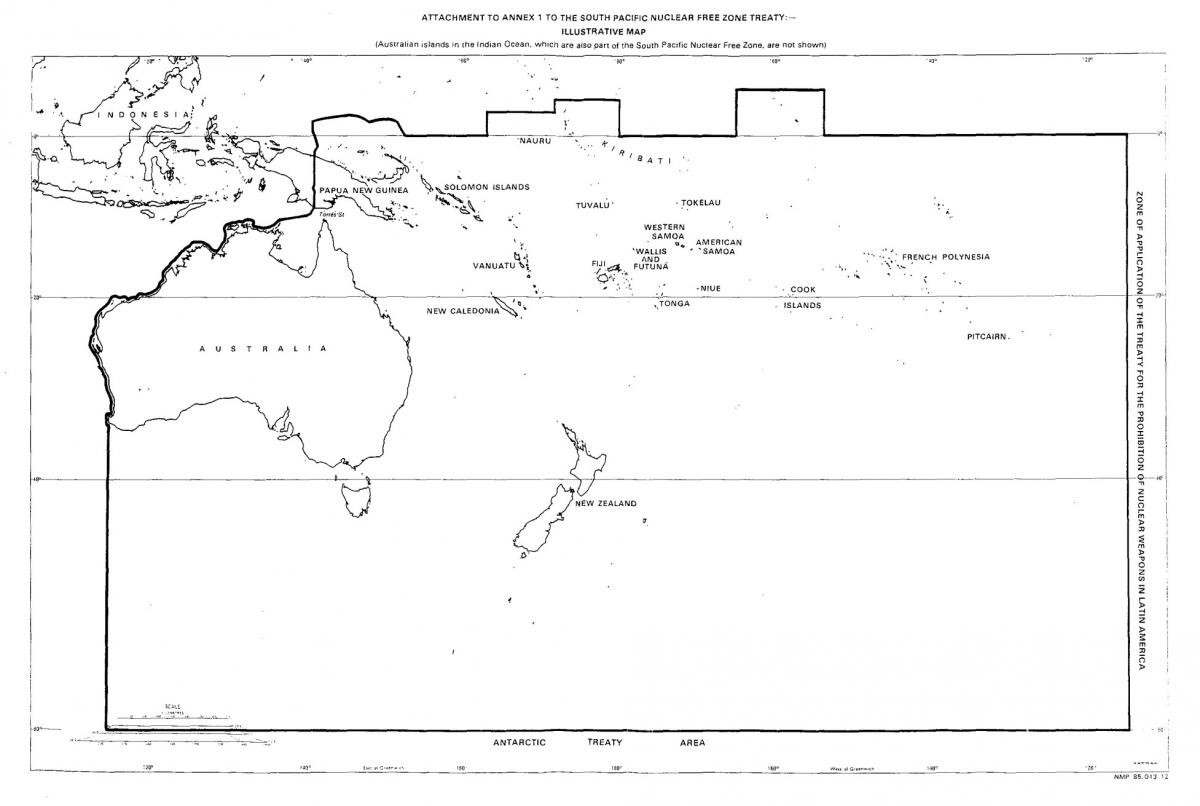Treaty of Rarotonga

Visual illustration of the South Pacific Nuclear Free Zone
Image source: Pacific Islands Forum
Overview
The Treaty of Rarotonga, the South Pacific Nuclear Free Zone Treaty, opened for signature on 6 August 1985 and entered into force on 11 December 1986.
The Treaty was borne of the South Pacific’s first-hand experience with nuclear weapons testing and was only the second NWFZ to enter into force in a populated region following the Treaty of Tlatelolco in Latin America.
The geographic scope of the Rarotonga Treaty is vast, extending from the West coast of Australia to the boundary of the Latin American NWFZ in the east, and from the equator to 60 degrees south, where it meets the boundary of the zone established by the Antarctic treaty (Article 1(a) Annex A, Rarotonga Treaty).
The Treaty of Rarotonga contributes to nuclear non-proliferation and disarmament by preventing the placement of nuclear weapons within the South Pacific by member states (Article 5).
The Rarotonga Treaty importantly reinforces, at the regional level, the legally-binding commitments that its States Parties have made under the near universal Treaty on the Non-Proliferation of Nuclear Weapons (NPT) not to manufacture, possess, acquire or have control of nuclear weapons (Article 3). The Rarotonga Treaty also includes an undertaking by States Parties to prevent nuclear testing in their territories (Article 6).
A further and quite distinctive feature of the Treaty is its emphasis on keeping the region free of environmental pollution by radioactive wastes and other radioactive matter (Article 7).
Full text of the Rarotonga Treaty is available at the UN Disarmament Treaties Database:
http://disarmament.un.org/treaties/t/rarotonga/text
Membership
The current States Parties to the Treaty are: Australia, Cook Islands, Fiji, Kiribati, Nauru, New Zealand, Niue, Papua New Guinea, Samoa, Solomon Islands, Tonga, Tuvalu, Vanuatu.
Internal Coordination Mechanisms
The Pacific Islands Forum (PIF) Secretariat located in Suva, Fiji, acts as the focal point for the Treaty while the operation of the Treaty is a regular agenda item at meetings of the Forum.
The PIF Secretary General is the depository for the Rarotonga Treaty and provides regular updates to Members, including as part of Leaders’ regular discussion of broader nuclear legacy issues in the Blue Pacific.
Current Activity and Priorities
At its 2019 Annual Meeting held in Funafuti, Tuvalu, PIF Leaders “acknowledged the importance of addressing the long-standing issues of nuclear testing legacy in the Pacific and called for the operationalisation of the provisions of the South Pacific Nuclear Free Zone Treaty (Rarotonga Treaty), as necessary”.

